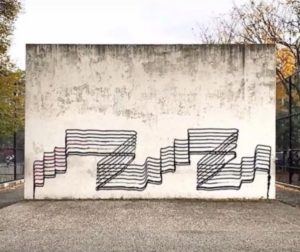In March, a law suit was filed by H & M against Jason “Revok” Williams, a wall art painter, seeking a declaration that it’s use of one of Williams’ pieces as background for an advertising video was lawful.[1] They claimed that the work, painted illegally on a wall of a New York City hand ball court, was vandalism and therefore unprotected by the copyright law of the United States. Responding to vocal criticisms from the artistic community and clothing industry and to threats of a customer boycott, they quickly withdrew the case.[2] But the underlying question about the rights held by artists painting both illegally and legally on exterior surfaces has been raised any number of time in recent years. The most prominent, of course, is the 5Pointz aerosol art moral rights dispute that recently resulted in a $6,750,000 judgment against the building owners for unlawfully mutilating and destroying 45 pieces, thereby violating the moral rights provisions of the American copyright code.[3] This is the Revok work used by H&M.[4]

Revok’s work was painted on the handball court wall in the William Sheridan Playground in the Williamsburg neighborhood in Brooklyn. The city parks department told H&M that the artwork was illegal and that royalties for its use were not owed to the city. Taking that as a grant of permission to use it in a video advertisement, they neither sought to discover who the artist was nor to obtain permission for its use. The ad was then created. They forgot that any copyright in street art is presumptively held by the artist not the property owner.
At least two issues emerge from this briefly contested tiff. First, H&M made the claim that illegal street art—“vandalism” in their language—is not protected by copyright. Second, assuming H&M had followed through with their law suit, would they have won even if Revok’s work was copyrightable? The first question is easy; the second is not so automatic.
Art painted illegally on a wall is clearly protected by copyright. The artist may be subject to arrest on a variety of different charges, but if the art itself is an original pictorial or graphic work fixed in a tangible medium of expression it gains the protection of federal law.[5] The originality requirement typically is easy to fulfill. And any work painted on a surface meets the fixation requirement. H & M’s claim that illegality voids a copyright was simply wrong.
But that doesn’t totally resolve the dispute. I can understand why H & M elected to drop its claim because of the negative publicity. And the likelihood that it would have won on the merits was quite small. But it is worth taking a quick look at the odds. Incidental displays of artistic works, even in commercial advertisements, may well be allowed by two doctrines–de minimus use and the fair use doctrine. The former simply notes that minor or incidental use of a work will not be infringing. Put simply, something worth noting has to happen to violate the law. Fair use, at least in this setting, works quite similarly. It concludes that an otherwise infringing use will be legitimate when the use is incidental, inconsequential, and has no negative economic repercussions on the value of the artistic work. We expect, for example, that art work displayed in public spaces will be viewed, photographed, and, perhaps, seen in the background of videos, in inconsequential ways. But in this case the work of art appeared as the background throughout virtually all of a ten second segment of a twenty second ad used in H & M’s “New Routine” advertising campaign.[6] Revok’s work was distinctly and prominently used. Since the purpose is commercial and Revok is an internationally known street artist, it is difficult for H & M to claim fair use. Their use was not merely incidental or inconsequential; and advertisers routinely pay artists for use of their works in advertisements like that created for H&M. This probably is a setting where, in the absence of their claim of “vandalism,” H&M would have paid for use of the pictorial work.
[1]. Alan Feuer, Brooklyn Lawsuit Asks if Illegal Graffiti Is Protected by Copyright Law, The New York Times (March 15, 2018), https://www.nytimes.com/2018/03/15/nyregion/brooklyn-graffiti-hm-lawsuit.html.
[2]. Jake Woolf, H & M Tried (and Failed) to Steal Graffiti, GQ.Com (March 16, 2018), https://www.gq.com/story/hm-tried-and-failed-to-steal-graffiti.
[3]. Cohen v. G&M Realty, L.P. (5Pointz II), No. 13-CV-05612, 2018 WL 851374 (E.D.N.Y. Feb. 12, 2018). I have written a lengthy article on this dispute. See Richard Chused, Moral Rights: The Anti-Graffiti Heritage of 5Pointz, 41 Colum. J. L. & Arts ___ (2018).
[4]. The image is contained in a video about the case. The author of the video is not named. The video may be found at https://www.bing.com/videos/search?q=h%26m+revok+ad+video&&view=detail&mid=4A3F82528650EFD8409E4A3F82528650EFD8409E&&FORM=VRDGAR.
[5]. The basic terms of protection may be found in 17 U.S.C. § 102, which provides, “Copyright protection subsists, in accordance with this title, in original works of authorship fixed in any tangible medium of expression, now known or later developed, from which they can be perceived, reproduced, or otherwise communicated, either directly or with the aid of a machine or device.” Pictorial, graphic, and sculptural works are among those listed as protected items.
[6]. A video segment can be seem on the AdAge site in a brief news item by Adrianne Pasquarelli, Art or Vandalism, H&M Graffiti Suit Could Have Big Implications for Ads, at http://adage.com/article/cmo-strategy/h-m-street-artist-big-graffiti-implications/312756/. The full ad, about twenty seconds long, can be seen in a video about Revok at https://www.youtube.com/watch?v=oiKThH1NMFE.

